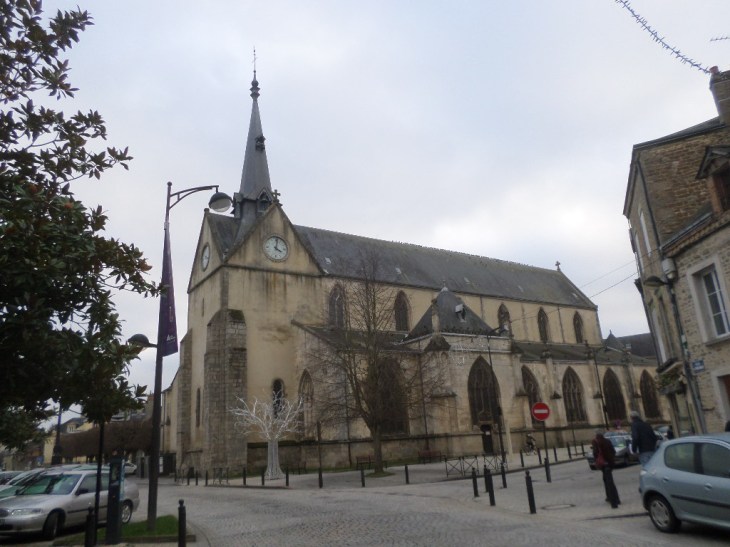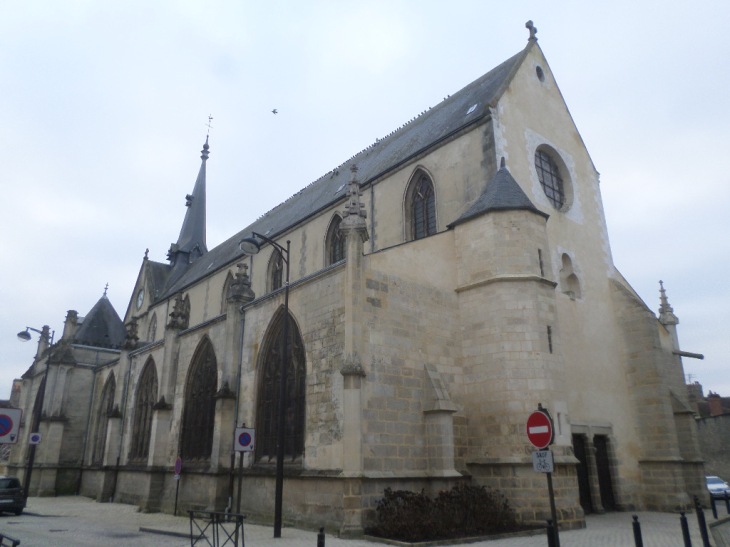I have passed many times, on my ways to Honfleur and Paris/Versailles, but never really went in town. So much beauty to see in my belle France, already the world’s most visited country (UN-WTO), and we have just touch the surface on things to see, really. I heard about the religious importance of Alençon and took it to finally stop by and see the town from our base in Honfleur. To my surprise , there were many things to see there, I found me older pictures mix in with other posts and decided deserves a post of its own, Before, for info, the city is in the dept 61 of the Orne, in the Normandy region. Therefore, here is my take on the Church Saint Leonard of Alençon !! Hope you enjoy the post as I.

The Church Saint Léonard came under the term of Saint-Léonard de Noblac. It is of flamboyant Gothic style; It was built from 1489 by Duke René, second Duke of Alençon, and then by his widow Marguerite of Lorraine in the early 16C. . It is under the tower of the bell tower that we can find the oldest trace of the church, with the first sanctuary dedicated to Saint-Martin de Tours, dating from the 12C. A first church, which was lost in the 13C, was near the sanctuary, but was not connected to it. It was deeply remodelled following the collapse of the vaults of the nave in 1645, The church underwent several restorations in the 17-18C before being refurbished in the 19C. It is located at the Place Marguerite de Lorraine.
The relics of Saint Leonard, who died in 570, were transported in 868 to Corbigny by the monks of Vandœuvre to preserve them from the Normans. Some of them were undoubtedly returned to 1025 thanks to the second Lord of Alençon, Guillaume I, and deposited in an ancient chapel dedicated to Saint Martin located on the site of the present Church Saint Leonard. A first church , attested between 1160 and 1182, was probably built very close to Saint Martin’s Oratory. This church disappeared in the middle of the 13C in forgotten circumstances, but parish life remained concentrated in the chapel until the end of the 15C. In 1490, two emblematic people of the City of the Dukes undertake to rebuild the church and made the Saint-Martin Oratory their private chapel: the Duke René of Alençon and his wife Marguerite de Lorraine then devoted a fortnight years, without ever being able to finish it. The present church, was built in the tertiary ogival style and inside in flamboyant Gothic,The Saint-Martin Oratory is the only example in Normandy which has a central vault key, much higher than the others, a characteristic that is rather found in the southwest of France and in Anjou.

The bulk of the work ranged from 1490 to 1505 and it was that same year that the church was placed under the term of Saint Léonard de Noblac, a character then more in vogue than Saint Léonard de Vandœuvre. On the stained glass windows of one of the eleven lateral chapels, which was for some time dedicated to Louis IX, ancestor of the Earls and Alençonnais dukes, and on the walls, were the coats of arms of the Houses of Alençon and Lorraine, now extinct. It was in this chapel that the Duchess and the Duke attended the office and in which a chimney that no longer existed was built for them. And it is visible to the naked eye, do observe, on the north facade of the church, the Gothic style of the 15C with the many small decorations, especially on the upper parts, the small balustrades decorated with lily flowers reminiscent of the links Dukes of Alençon with royalty. The southern facade has not been completed and is not at all decorated. It should also have been doubled by a polygonal porch. Entrance through the small door, northern facade, led to the first chapel dedicated to Saint Michel, patron of the Kingdom of France. In this chapel, or nearby, under the steps of visitors, was a large stone on which was represented a heart, that the passage and friction over the centuries have unfortunately erased: when he died in 1492, René d’Alençon was buried for the first time in the church and its heart, placed in a lead box itself in the shape of a heart, had been deposited under a stone. When at about 1510, René ‘s heart was transferred to the Church of Saint-François de Mortagne, the empty box was left in his vault. In 1776, the stone, which also bears the imprint of a heart, is removed, then put back in its place, and this impression, erased by the friction of the feet, no longer exists than in memory. At Easter 1645, the granite vault of oak crumbles was replaced by a simple cradle of plaster, it was only in 1836 that a new vault of Gothic style was built. The main door is arranged in 1663 and the clock is laid in 1727.
Until 1789, this Church Saint Leonard did not possessed baptismal fonts. The altar and the carved wooden pulpit, two side consoles and some modern stained glass windows for the most part, deserve the attention of the visitor. The main façade, which was probably never completed, is thought to have been doubled by a polygonal porch, like in Notre-Dame. The last church work dates from 1897, with the reconstruction of Saint-Fiacre Chapel, in the south side aisle. The western facade houses an unframed door; it is flanked by two buttresses on the left, and an internal staircase and a buttress on the right. The bedside has two levels of elevation: the first pierced with small windows and the second with clocks. Above the apse is the bell tower. The second chapel, dedicated to Saint Léonard de Noblat, pays tribute to the one who has unequivocal the name of the church. And yet, this has not always been the case! Before its reconstruction, the church was dedicated to another Leonard, Saint Léonard de Vandoeuvre, a hermit who would have founded Saint-Léonard-des-Bois. René d’Alençon and Marguerite de Lorraine began the work and awarded him a new dedication: their choice stops on Saint-Léonard-de-Noblat, protective patron and liberator of prisoners. We know that Saint Léonard de Noblat would have been baptized at the same time as Clovis, in 496. He would have obtained authorization to visit the prisons and release prisoners whose conduct could be bought. Now we know why their choice focused on Saint Léonard de Noblat ! Before becoming a prince of blood worthy of the name, and to marry Marguerite, the young René had a lot of debts and he fought a lot against the power of his cousins, kings of France, in particular Louis XI who had ended up in jail. René was only released when the king died in 1484. You will now know why, on the stained glass window of the chapel which dates from 1886, Saint Léonard is represented with chains open in his hands.
Finally, if you look up, in the nave, you will see only the current vault is not of origin: the vault of the time, in granite of Herté, quarry of the Alençon region, collapsed In 1645 and was rebuilt in plaster in a neo gothic style. Usually closed to the public, it was possible to discover it from the inside, during an unprecedented visit scheduled by the Tourist Office,
The city of Alençon on its heritage: https://alencon.fr/mes-sortiesmon-temps-libre/tourisme-et-patrimoine/monuments-et-architecture/
The Alençon tourist office on its heritage : https://www.visitalencon.com/d%C3%A9couvrez-alen%C3%A7on?lang=en
The Orne dept 61 tourist office on Alençon: https://www.orne-normandy-travel.co.uk/destinations/alencon/
The Normandie region tourist office on Alençon: https://en.normandie-tourisme.fr/unmissable-sites/alencon/
There you go folks, a nice church in a pretty district of wonderful Alençon. I say its worth a detour by all, and has easy road connections, Again, hope you enjoy the post on the Church Saint Leonard of Alençon as I
And remember, happy travels, good health, and many cheers to all !!!
